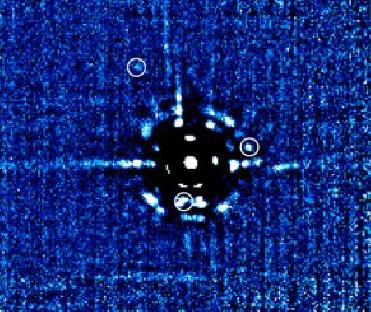
Image of the HR 8799 system. In the center, the host star HR 8799. Further investigation shows that three of the specks surrounding the star are planets. MPIA / W. Brandner Photo.
HEIDELBERG, GERMANY (BNS): Astronomers have obtained the first direct spectrum - the "chemical fingerprint" of an exoplanet by studying a triple planetary system.
According to a news release by Max Planck Institute for Astronomy, the study has brought out new insights into the planet's formation and composition. The result has provided a milestone in the search for life elsewhere in the Universe.
The research team studied the planetary system around the bright, very young star HR 8799, 130 light-years from Earth, located within the constellation Pegasus. The planetary system includes three giant planets.
�Our target was the middle planet of the three, which is roughly ten times more massive than Jupiter and has a temperature of about 800 degrees Celsius,� said Carolina Bergfors of Max Planck Institute for Astronomy, as reported in the release.
The spectrum was recorded using the NACO instrument installed at the European Southern Observatory's Very Large Telescope (VLT) in Chile, and also it's combined camera/spectrograph CONICA, which was developed at the MPIA and at the Max Planck Institute for Extraterrestrial Physics.
Astronomers measured the planet's spectrum, a �chemical fingerprint� by examining the light received from the planet.
The astronomers hope that this technique will help them gain a better understanding of how planets form.
 Previous Article
Previous Article Next Article
Next Article













The Indian Air Force, in its flight trials evaluation report submitted before the Defence Ministry l..
view articleAn insight into the Medium Multi-Role Combat Aircraft competition...
view articleSky enthusiasts can now spot the International Space Station (ISS) commanded by Indian-American astr..
view article